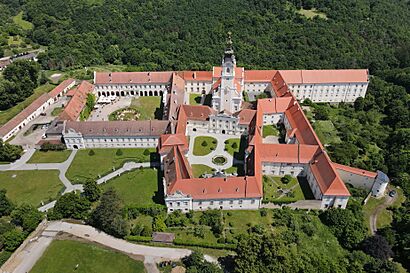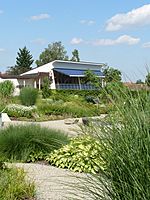Altenburg Abbey facts for kids
Altenburg Abbey (German: Stift Altenburg) is an old Benedictine monastery in Altenburg, Lower Austria. It's about 30 kilometers north of Krems an der Donau in an area called the Waldviertel. Countess Hildeburg of Poigen-Rebgau started the monastery in 1144.
Throughout its long history, the abbey faced many attacks and was destroyed several times. For example, the Swedes destroyed it in 1645. Later, in 1793, Emperor Joseph II made a rule that the abbey couldn't accept new monks. But unlike many other monasteries in Austria, Altenburg Abbey managed to stay open and active.
The abbey looks the way it does today because of abbots Maurus Boxler and Placidus Much. They oversaw a big renovation in the Baroque style. The architect Josef Munggenast led this work. He had help from famous Austrian artists like Paul Troger who painted amazing frescoes (wall and ceiling paintings). Franz Josef Holzinger did the stucco work (decorative plaster), and Johann Georg Hoppl worked on the beautiful marbling. Many people say the Baroque buildings that replaced the older ones are some of the best in Austria.
History of Altenburg Abbey
Altenburg Abbey was founded in 1144 by Countess Hildeburg of Poigen-Rebgau. Scientists have found old walls from the 12th century and a Romanesque cloister (a covered walkway) from the 13th century. This shows how old the monastery really is!
The monastery was attacked and rebuilt many times. For example, it was attacked in 1251 by Hermann V von Baden. Then, between 1304 and 1327, the Cumans attacked it. It also faced attacks during the Hussite Wars from 1427 to 1430. In 1448, groups from Bohemia, Moravia, and Hungary attacked it, and the Turks attacked in 1552. In 1645, the Swedes destroyed the abbey.
After the Thirty Years' War in the 17th and 18th centuries, the abbey was rebuilt. It got its current Baroque look under abbots Maurus Boxler and Placidus Much. The architect Josef Munggenast led the work. Famous artists like Paul Troger (for frescoes), Franz Josef Holzinger (for stucco), and Johann Georg Hoppl (for marbling) helped.
In 1793, Emperor Joseph II made a rule that the abbey couldn't accept new monks. But Altenburg Abbey managed to stay open, unlike many others in Austria. After the Revolution of 1848, the abbey sold some valuable items to pay off its debts.
During World War II, the abbey faced difficulties. On March 12, 1938, Abbot Ambros Minarz refused to fly the Swastika flag. Because of this, the Sturmabteilung (a Nazi group) occupied the abbey. For a short time between 1940 and 1941, the abbey was closed by the Nazis. The abbot was arrested, and the monks lost their home. After the war, from 1945, Soviet soldiers used the buildings. Under Abbot Maurus Knappek (1947–1968), the buildings were fixed, and the community of monks returned.
Since 1625, the abbey has been part of the Austrian Congregation, which is now part of the Benedictine Confederation. During recent digs, archaeologists found a medieval "monastery beneath the monastery." They found a dining hall, a meeting room, living areas for the monks, a cloister, a writing room, and a Gothic St. Vitus Chapel.
Layout of the Abbey
The abbey covers a very large area. The front of the building, which faces east, is 200 meters long! It is surrounded by many beautiful gardens. The abbey complex has 12 main areas:
- 1. Fountain Court
- 2. Convent Court
- 3. Kitchen Court
- 4. Prelates Court
- 5. Church Court
- 6. Johann's Court
- 7. Great Abbey Court
- 8. Abbey Church
- 9. Library Wing (Crypt)
- 10. Marble Wing (Sala terrena)
- 11. Inner Medieval Monastery (Cloister)
- 12. Outer Medieval Monastery
Special Features
Inside the abbey, you can see a mix of Baroque and Rococo styles. These styles use lots of fancy stucco (decorative plasterwork). When the abbey was rebuilt, they added the library, the imperial staircase, and the marble hall.
The staircase, the abbey church, and the library are famous for their frescoes (wall and ceiling paintings) by Paul Troger. The paintings in the entrance to the library were done by his student, Johann Jakob Zeiller.
The library was built in 1740. It's a grand Baroque room that is three stories high! The main hall of the library is 48 meters long. Its ceiling is covered with amazing frescoes by Paul Troger. Some of the most famous paintings show the Judgment of Solomon, the Wisdom of God, and the Light of Faith. Below the library is a large crypt (an underground room). It also has many frescoes by artists whose names we don't know. One interesting scene there is the Dance of Death.
The church is shaped like an oval and has a large dome. Joseph Munggenast renovated it between 1730 and 1733. The dome is also decorated with frescoes by Troger. The main part of the altarpiece (the artwork behind the altar) is a painting of the Assumption of Mary. Above it, there is a picture of the Trinity.
Gardens
In recent years, the monks have created many beautiful gardens around the monastery. They planted these gardens themselves, with help from a project called Natur im Garten and local plant nurseries.
Der Garten der Religionen (the Garden of Religions) is the largest garden. It used to be the abbey park and was used for growing Christmas trees and fruit trees. Now, this garden has five special areas, each dedicated to one of the world's main religions: Hinduism, Buddhism, Judaism, Christianity, and Islam. It also has a large natural pond surrounded by wild flowers, a group of trees, and an old plum grove where you might see local animals. There's also an apple tree area that reminds visitors of the "monastery under the monastery."
Der Apothekergarten (the Apothecary Garden) is on the eastern side of the monastery. This spot used to have a herb garden where plants were grown for medicine in the Middle Ages. The new garden uses modern science to grow plants.
Der Schöpfungsgarten (the Garden of Creation) is on the southern part of the abbey church. It used to be called the Source Garden. The theme of this garden is the story of creation. There's a bench under a large walnut tree, which is said to be a great spot on a hot summer day.
Der Garten der Stille (the Garden of Tranquillity) is the newest garden. It's on the east side where there used to be a game reserve. This garden has a natural look with an orchard, a vineyard, an area for butterflies, insect hives, and a hobby garden. There are 11 stone sculptures by Eva Vorpagel-Redl placed along paths that lead to the forest. From a special platform here, you can see the impressive eastern side of the chapel and the eastern part of the medieval monastery.
Der Kreuzganggarten is simply the garden inside the cloister (the covered walkway).
Gallery
See also
 In Spanish: Abadía de Altenburg para niños
In Spanish: Abadía de Altenburg para niños















